Rathfarnham Castle
Published in Gems of Architecture, Issue 5 (September/October 2019), Volume 27Rathfarnham, Co. Dublin
By Muirne Lyons
Rathfarnham Castle is a sixteenth-century semi-fortified house with an eighteenth-century Georgian interior. It was built in 1583 by Adam Loftus (c. 1533–1605), who came to Ireland in 1560 and quickly rose to a number of prestigious positions, including archbishop of Dublin and lord chancellor of Ireland. As archbishop, Loftus deemed the existing palace in Tallaght remote and unsuitable. Following a successful petition to the Crown, he acquired a new estate in Rathfarnham, recently confiscated from Viscount Baltinglass.
The castle consists of a rectangular central block with a tower on each of its four corners, allowing flanking fire along each side. The outlines of two gun loops, long since filled in, can be seen on either side of the main door, while additional loops were temporarily uncovered during recent conservation of the deep walls. The outlines of small mullioned windows on each stage of the northern towers give some indication of how dimly lit the interiors originally were. Very little evidence survives of the battlements that protected marksmen on the roof, as the parapet, like much of the castle, was de-fortified by successive owners in response to the diminishing threat of attack.

Above: Rathfarnham Castle—a sixteenth-century semi-fortified house with an eighteenth-century Georgian interior. (NIAH)
Rathfarnham Castle passed by inheritance to Philip Wharton (1698–1731), bon viveur and luckless gambler, who sold the property to cover his debts. The new owner was William ‘Speaker’ Conolly (1662–1729), whose tenant, Dr Edward Worth (1676–1733), made unspecified ‘improvements’ that may have included the opening up of the windows. The next owner, Archbishop John Hoadly (1678–1746), left the estate to his daughter Sarah, whose husband, Bellingham Boyle (1709–71), is believed to have continued the transformation into a comfortable Georgian house. The semicircular bow overlooking the gardens was certainly in place by the time the profligate Boyles, saddled with debts, sold the estate to a distant descendant of the original builder, thus beginning the second period of Loftus ownership.
Henry Loftus (1709–83), created earl of Ely in 1771, had the greatest impact on the architecture of Rathfarnham Castle since its foundation almost two centuries earlier. A visitor in 1770 described the house as ‘an old one of which only the shell is preserved … some of the rooms within [being] fitted up after the designs of Mr Stuart’s’, showing the extent of reconstruction under way and, with the mention of James ‘Athenian’ Stuart (1713–88), the calibre of architect involved. Stuart, a pioneer of the chaste neoclassical style, is credited with the decoration of the saloon, which spans almost the entire length of the principal floor and features a geometric ceiling filled with motifs inspired by Greek and Roman antiquity. Sir William Chambers (1723–96) is credited with the bow-ended gallery on the upper floor, where, in order to prevent putting pressure on the floor below, the columns are of timber painted to simulate stone.
Rathfarnham Castle ceased to be a family home in 1913, when it was purchased by the Jesuits. Its sale in 1985 sparked fears for its future, but it was declared a national monument in 1986 and purchased by the State the following year. The castle, managed by the Office of Public Works, is open to the public. The dining room in particular should be of interest to the archaeologist and architectural enthusiast, its state of ‘arrested decay’ allowing visitors to explore, in one room, the multi-layered history of this fascinating place.
Muirne Lyons has a master’s in urban and building conservation, works as an information officer with the Office of Public Works in Rathfarnham Castle and is now with the National Monuments Service in the Department of Culture, Heritage and the Gaeltacht. Series based on the NIAH’s ‘building of the month’, www.buildingsofireland.com.
















